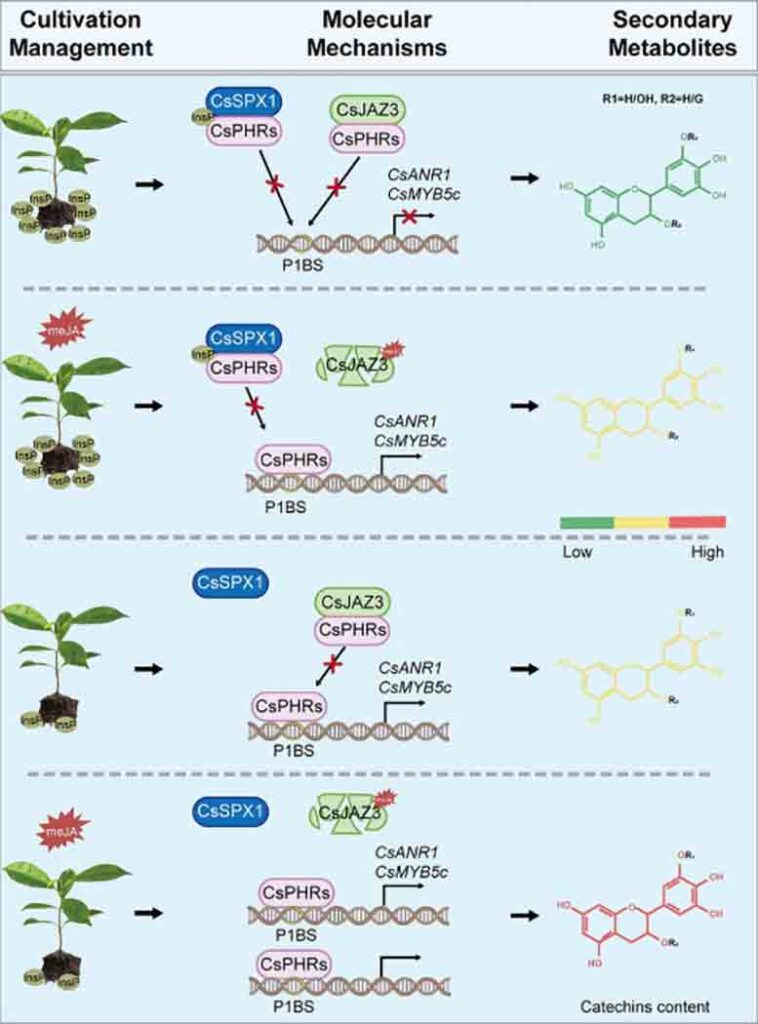Discover the Hidden Connections Between Nutrients and Health in Your Favorite Tea!
phosphate jasmonate regulate tea catechins
New Study Reveals How Phosphate and Jasmonate Pathways Regulate Tea’s Health-Promoting Catechins
A recent investigation reveals the intricate dynamics between phosphate (Pi) signaling and jasmonate (JA) pathways in tea plants, elucidating their role in the regulation of catechin biosynthesis—compounds known for their considerable health advantages.
This study has unraveled the multifaceted interactions that govern the production of catechins, crucial for both the economic significance of tea and its health-promoting properties. It sheds light on the various environmental and hormonal factors that influence the synthesis of these vital compounds.
Catechins are the primary active ingredients in tea, celebrated for their protective effects against a range of health issues, including diabetes, cancer, and cardiovascular ailments. Nevertheless, the biosynthesis of these compounds is acutely affected by environmental conditions, notably the availability of phosphate (Pi), which is frequently limited in the soils suitable for tea cultivation.
Such a deficiency can detrimentally impact tea quality by hindering the accumulation of secondary metabolites. Therefore, comprehending the molecular mechanisms that regulate catechin production amid fluctuating nutrient conditions is of paramount importance.
Key Transcription Factors and Their Roles: phosphate jasmonate regulate tea catechins
Conducted by researchers at the Zhejiang Academy of Agricultural Sciences and published in Horticulture Research on June 27, 2024, this study delves into the complex relationship between phosphate signaling and jasmonate pathways in tea plants. The scientists pinpointed two essential transcription factors—CsPHR1 and CsPHR2 (phosphate starvation response)—that play a crucial role in phosphate signaling, alongside CsJAZ3 (Jasmonate ZIM-domain), a repressor within the jasmonate pathway.
These components collaboratively modulate catechin biosynthesis in response to variations in nutrient levels and hormonal signals, providing groundbreaking insights into the genetic determinants of tea quality.
The research indicates that phosphate deficiency triggers vital genes involved in catechin biosynthesis through CsPHR1 and CsPHR2, elevating the expression of CsANR1 (anthocyanidin reductase) and CsMYB5c (Myeloblastosis), both integral to catechin production. Furthermore, CsSPX1, a repressor of the phosphate pathway, was found to inhibit the activity of CsPHR1 and CsPHR2, thereby fine-tuning the plant’s response to phosphate levels.

Interactions Between Phosphate and Jasmonate Pathways
Additionally, the study elucidates how CsJAZ3 interacts with CsPHR1 and CsPHR2, establishing a crucial link between jasmonate signaling and phosphate regulation. This interaction is vital for maintaining the plant’s adaptive response to nutrient stress and hormonal fluctuations, ultimately affecting catechin levels and the overall quality of tea.
Dr. Gaojie Hong, the principal investigator, remarked, “Our research unveils a sophisticated regulatory network in which phosphate and jasmonate pathways converge to manage catechin biosynthesis in tea plants. These revelations not only enhance our comprehension of tea metabolism but also provide potential avenues for improving tea quality through targeted genetic and environmental management.”
The discovery of the CsPHRs-CsJAZ3 regulatory module presents significant prospects for the tea industry. By judiciously manipulating these pathways, it is feasible to augment catechin concentrations, thereby enhancing both the quality and health benefits of tea. Such findings could guide the development of optimized cultivation strategies aimed at improving nutrient efficiency, minimizing environmental stressors, and boosting the economic and nutritional value of tea, positioning it as a more sustainable crop for the future.
Reference
“CsPHRs-CsJAZ3 incorporates phosphate signaling and jasmonate pathway to regulate catechin biosynthesis in Camellia sinensis” by Linying Li, Xueying Zhang, Da Li, Hui Su, Yuqing He, Zelong Xu, Yao Zhao, Yiyi Hong, Qingsheng Li, Ping Xu and Gaojie Hong, 27 June 2024, Horticulture Research.
DOI: 10.1093/hr/uhae178
This research was supported by the Zhejiang Provincial Natural Science Foundation of China under Grant Nos. LQ23C020003 and LR22C020003, the National Natural Science Foundation of China under Grant No. 32272553, the Major Science and Technology Special Project of Variety Breeding of Zhejiang Province (2021C02067-7 and 2021C02064-6), and the State Key Laboratory for Managing Biotic and Chemical Threats to the Quality and Safety of Agro-products (2021DG700024-KF202102).







